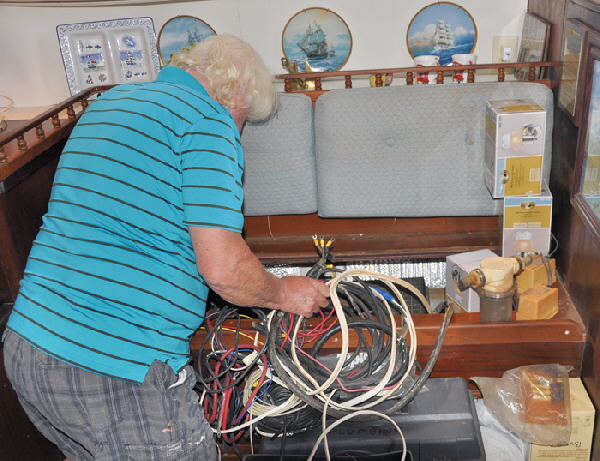I’m sure every yachtsman who ever worked on his boat has more than once spent more time looking for tools and spares, than it took to do the actual job. You would think there would be enough room on Britannia’s 45’ foot hull with her 14’ foot beam for all the tools and spares under the sun, and there pretty much is, but that also creates its own problems. I can stow a workshop full of tools and spare parts. but that doesn't mean I can always find them. I would frequently, and quite literally, spend more time trying to find something; be it the right sized screw, a special tool or part, than it took to do the darn job! I would sometimes give up completely and sleep on it, knowing there was a chance it might come to me in the morning. It would often cause arguments between my wife and I, “I don't know where you put the damn thing!” she would say, “You never put them back in the same place anyway, so how can you expect anybody to remember where you put so many things?” Kati was right, so I decided to do something about itm if only for the sake of our sanity.
On a boat Britannia’s size it is often possible to stow spare parts relating to a particular “trade” like plumbing, woodwork, electrical, deck fittings, etc., all together in one location, which definitely makes it easier to at least go to the right place. On a smaller craft that's not always practical, so you find yourself rummaging through things that are not even relevant to the thing you want, and it's very frustrating when you eventually find it somewhere different.
HERE IS MY REMEDY:
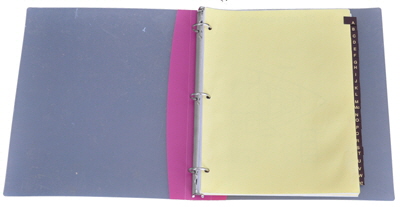 I have found the answer is to accurately catalog items wherever they are kept. I doesn't matter whether it's a special shackle or a spare alternator, so long as you have a method of finding it. It's no good doing an Excels spread sheet either, or any other computer program. We tried that first, and you can bet your life the laptop battery would be flat when we opened it, and if someone else was searching for something they might not be able to work the laptop anyway. The remedy is to make a hard copy book, and keep it in a place where you will always find it, maybe in the chart table, but if you can't even find the book, then you really are in trouble.
I have found the answer is to accurately catalog items wherever they are kept. I doesn't matter whether it's a special shackle or a spare alternator, so long as you have a method of finding it. It's no good doing an Excels spread sheet either, or any other computer program. We tried that first, and you can bet your life the laptop battery would be flat when we opened it, and if someone else was searching for something they might not be able to work the laptop anyway. The remedy is to make a hard copy book, and keep it in a place where you will always find it, maybe in the chart table, but if you can't even find the book, then you really are in trouble.
First I bought a loose leaf spring binder with an alphabetical index and plenty of blank pages, along with a pencil with an eraser on the end. This become “Thee Book.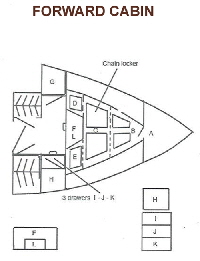 ”
”
Second I made a rough drawing of every cabin on Britannia where things are stowed, which of course means everywhere! Starting with the fo’c’sle for example, we have two spacious storage compartments under the V births, a hanging locker to stab’d, along with a set of four drawers and a cupboard above them. There is a locker to port with four shelves and a second hanging locker. The bank of drawers and the locker with shelves needed a frontal sketch labeling them on the drawing as A,B.C, etc., Other storage compartment were done in the same way, until I had an actual drawing of everywhere items were stowed.
One fateful weekend we began the tedious and time consuming operation of cataloging every single item on Britannia. I never dreamed it would take four weekends and run into many hundreds of items, but I assure you my dear reader, if you have the same problem finding bits, then it will be well worth it, with many more hours saved in finding things in the future.
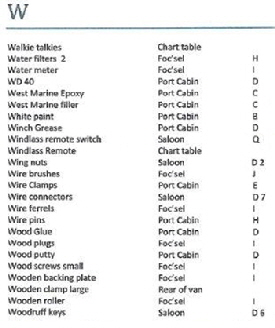 This is really a two person job, one calling out the item and location, the other writing it down, and this is where it becomes tedious. Every single part that is stored in every single drawer, shelf or locker must be cataloged in the appropriate page of the book. Many things have more than one name, so it also pays to call a nautical item by a simple generic term as well, so that landlubbers who might be helping you can also locate it. For example: my numerous Jiffy bags of various sizes of wood plugs go under page W for Wood plugs, and also under P for Plugs wood. Thus they can be found in pages W and P in fo’c’sle cupboard C. It is then a simple matter to look at the fo’c’sle sketch and seeing which cupboard is C and bingo! it's that simple for anyone on the boat. Yes, a major advantage of the book is that everyone else in the crew can also locate things quickly.
This is really a two person job, one calling out the item and location, the other writing it down, and this is where it becomes tedious. Every single part that is stored in every single drawer, shelf or locker must be cataloged in the appropriate page of the book. Many things have more than one name, so it also pays to call a nautical item by a simple generic term as well, so that landlubbers who might be helping you can also locate it. For example: my numerous Jiffy bags of various sizes of wood plugs go under page W for Wood plugs, and also under P for Plugs wood. Thus they can be found in pages W and P in fo’c’sle cupboard C. It is then a simple matter to look at the fo’c’sle sketch and seeing which cupboard is C and bingo! it's that simple for anyone on the boat. Yes, a major advantage of the book is that everyone else in the crew can also locate things quickly.
Every cabin or compartment where things or stored should to be itemized in this way, including outside lockers, deck boxes or lazarettes. How deep you delve into this process is up to you. I have a compartmented box of different sizes of electrical wire crimp fittings, that are all cataloged under the general name “electrical terminals,” and when I open the box I can easily choose the crimp terminal I want. But then I also have a compartmented box of many different small items, that are all in the book individually. During this long process you may even find things you never knew you had, or a different place to where they should be. Whatever you do, just catalog it in your book, under as many 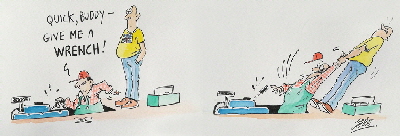 separate headings as it takes to make them easier to identify.
separate headings as it takes to make them easier to identify.
Being an Englishman living in America I have a secondary problem. Things are called different names by English sailors, (not to mention spelling), so if you happen to have a Brit’ on board as crew, then there is a further dimension to the book. Many of the nautical differences are explained in Viva La Difference.
You will eventually finish up with your book full of items on each alphabetical page, but they will not be in alphabetical order because you wrote them down as you found them. Some pages will be full of items, others not, like X that in my book has only one item, Xylene, that is also under S for Solvents.
Having finished the actual cataloging, this is the point where you open your computer and re-type each item on a page in alphabetical order. Thus, on page W I have 25 items starting with walkie-talkies and the last being Woodruff keys. I’m sure there is a program somewhere that re-calibrates lists into alphabetical order with one click, but I don't have it. So this job was also tedious, but it does save tine scouring through a long list on the same page. Having compiled a neat alphabetical page, print it and put it in the book. Now also trace over your drawing with a ballpoint pen or make a new drawing, as I did using Photoshop. If you leave your original list in pencil it will slowly fade and you won't know which compartment is which. Incidentally, all this effort will someday impress a potential buyer immensely.
It almost goes without saying; it is very important to put things back where they came from after use, or the system breaks down. This might sound simple common sense, but it is easy to slip a tool back in the wrong place. In other words, become methodical and your efforts will pay dividends in time saved looking for things, and the frustration of emptying a locker, only to find the item somewhere totally different.
Being able to find things quickly can also be an actual lifesaver in emergencies. Once, a friend who was stronger than he looked, snapped the end off a sea-cock while trying to close it with a wrench. He plugged the inrush of water with this hand while my wife looked in the book and found wooden seacock bungs in the saloon stab’d side seating, and in a jiffy the seacock was plugged. The bungs are now attached to their respective seacocks where they should have been in the first place, and that particular item is erased from the book.
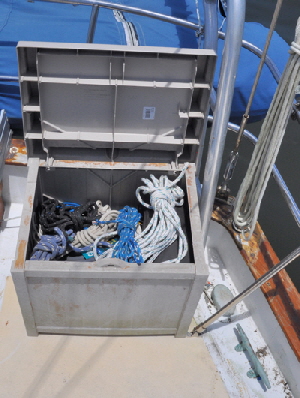 Recently I looked everywhere for a specially spliced length of line that acted as the fore-staysail topping lift. I couldn't find it anywhere and eventually gave up and made a new one using 30’ feet of new rope. Later, when I was rummaging through one of our aft deck boxes I found the line in the bottom of the box. It had been thrown in and not entered in the book. Me, methodical, not always. Just do as I say, not as I do.
Recently I looked everywhere for a specially spliced length of line that acted as the fore-staysail topping lift. I couldn't find it anywhere and eventually gave up and made a new one using 30’ feet of new rope. Later, when I was rummaging through one of our aft deck boxes I found the line in the bottom of the box. It had been thrown in and not entered in the book. Me, methodical, not always. Just do as I say, not as I do.
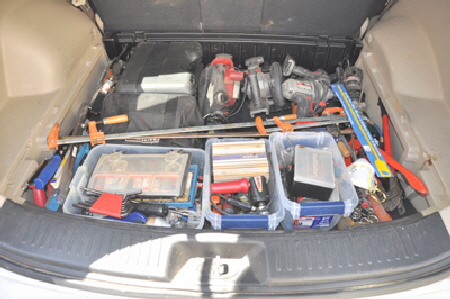 So what do you do with those more common tools that you use both on your boat, and also at home or your work? One reason I bought a KIA SUV was because it has a very large carpeted storage space under the rear floor. Other vehicles have this space, but it is commonly used to store the spare wheel, but the KIA spare is beneath this storage area. This free space is perfect for keeping these multiple-use tools, like my circular saw, Dremel kit, belt sander, electric planer, clamps, etc., and a multitude of other items, under “KIA” in the book. If your vehicle doesn't have a space like this you need to store these common tools in a box in the vehicle, or buy duplicates. Otherwise, when you need something on the boat, for sure it will be in your garage, and vise-versa.
So what do you do with those more common tools that you use both on your boat, and also at home or your work? One reason I bought a KIA SUV was because it has a very large carpeted storage space under the rear floor. Other vehicles have this space, but it is commonly used to store the spare wheel, but the KIA spare is beneath this storage area. This free space is perfect for keeping these multiple-use tools, like my circular saw, Dremel kit, belt sander, electric planer, clamps, etc., and a multitude of other items, under “KIA” in the book. If your vehicle doesn't have a space like this you need to store these common tools in a box in the vehicle, or buy duplicates. Otherwise, when you need something on the boat, for sure it will be in your garage, and vise-versa.
Finally, never forget to add anything you have recently bought, and delete any consumables you have used up and not yet replaced. In other words keep the book current, because someone else might need to reference it in a hurry, when you are not around.
The total number of items we have cataloged to date is 360. No wonder it was impossible to remember what we have on Britannia and where things are stowed. Now I don't have to, and my memory has room for important things like; “Now where did I put that beer?”
